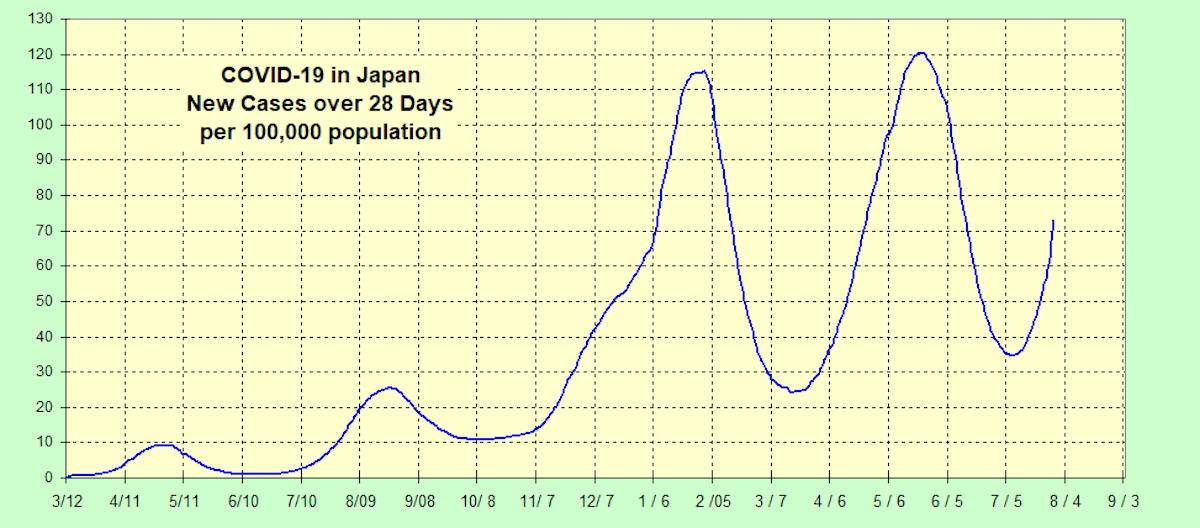(MENAFN- Asia Times) New Covid-19 cases in Japan were on the brink of 10,000 for the first time this week, casting a cloud over the Olympics, according to media reports. The confirmed official figure was 9,470 as of Thursday, so the 10,000 figure was likely to be surpassed on Friday.
Thanks to gold medal wins by Japanese athletes, longstanding popular opposition to the games had dipped below half of those polled following the opening ceremony. Now, the opposition again appears to be gaining ground.

Not backing down There is little indication, however, that the government and the International Olympics Committee will change course. Two factors, which could change very quickly, back their posture.
First, hospital bed occupancy by Covid 19 patients is still only around 48,000. During past peaks, Covid-19 patients occupied more than 70,000 beds in both January and May this year when daily cases were around 7,000.
It appears the current wave is hitting mostly the younger generation. The average age of patients in previous peaks was much higher.
Fatality data show a similar trend. After the vaccination of seniors began late this spring, the fatality rates began to decline.

This apparently is now a pandemic of the younger generation with stronger immune systems.
The Delta variant But the virus has changed and nations around the world are experiencing new upswings. About 70% of new cases in Japan are now the delta variant.
Could the US Centers for Disease Control again raise Japan from Level 3 to Level 4, which means travelers should avoid all travel to Japan? Currently, countries such as Brazil, Indonesia and Spain are classified as Level 4.
Japan is currently among Level 3 countries such as Belgium, France and Sweden for which the CDC's recommendation is,“Travelers should avoid all nonessential travel.”
The CDC's message for travelers to Level 2 countries, such as Finland, Germany and Kenya is,“Travelers at increased risk for severe illness from Covid 19 should avoid all nonessential travel.”
Interestingly, the number of the safest, Level 1, countries has increased from 29 earlier this year to 59 currently – including Australia, Hong Kong, New Zealand, South Korea and Taiwan.
Mathematical methodology The CDC's statistical model for classifying countries and regions is pretty straightforward.
It first checks whether the PCR testing regime is robust or not: How many tests have been conducted per 100,000 population over the previous 28 days?

A total of 18.2 million PCR tests have been conducted to date in Japan and during the most recent 28 day period, over 1,380 tests per 100,000 people were recorded.
The CDC ranks these figures into three groups. The best category is more than 1,500 tests per 100,000 people over 28 days. That's followed by the second-best, 100 to 1,500 tests. Finally, there's the group with fewer than 100 tests. Japan is now well into the second-best category.
This year the CDC consolidated these groupings from four categories: more than 1,200 tests per 100,000, followed by 401 to 1,200, then 200 to 400 – and, finally, fewer than 200 tests.
Test-to-case ratio
Among those countries in the second-best category for tests, the CDC next examines the test-to-case ratio. Last summer, Japan conducted over 100 tests for each actual case it uncovered during a 28 day period. The ratio is now down to about 19.

The CDC ranks these figures into three categories: The best group has performed more than 30 tests per case uncovered. The middle group is from 10 to 30 tests and then there are those with fewer -than 10 tests. Here Japan ranks in the-middle-of-the-middle group.
Incident Rate The CDC finally looks at the number of new cases over the previous 28 days per 100,000 population.

The CDC classifies this middle-of-the-middle group into three levels (with no possibility for Level 1): Regions with fewer than 99 cases are classified as Level 2. Those with 100-500 cases are classified as Level 3 and those with more than 500, Level 4.
Under these criteria, Japan should have been classified as Level 2 in late June. Instead, the classification has remained at Level 3 and there is more room to go before things deteriorate to Level 4.
Level 4 during the Games is mathematically impossible Things could deteriorate with the Delta variant, but the possibility of case counts rising to more than 500 cases per 100,000 over 28 days would be mathematically impossible before the Games end on August 7.
So there should be no cold shower from the US CDC during the games.
But then there is the Games' aftermath to consider.
Recent reproduction rate

In the above chart, the blue line is the R (reproduction rate): How many people are getting newly infected by those known to be infected at the time.
As recently as early June the R was less than 0.8, meaning ten infected people were infecting only eight new patients. Now with the Delta variant accounting for 70% of the new cases, the R has jumped to 1.4 even without the help of a long weekend when the virus tended to spread widely.
The gray columns show incidents of long weekends with holidays on either Fridays or Mondays. It also includes weekends with holidays on either Tuesdays or Thursdays when people are likely to take a day off.
The red arrows indicate instances when such long weekends were followed by jumps in the R. The most recent long weekend was Golden Week, which was predictably followed by the spike.
The long Obon holidays of August should be closely watched. Let the ancestral spirits return as usual – but with a minimum of contagion.
MENAFN30072021000159011032ID1102542069
Legal Disclaimer:
MENAFN provides the information “as is” without warranty of any kind. We do not accept any responsibility or liability for the accuracy, content, images, videos, licenses, completeness, legality, or reliability of the information contained in this article. If you have any complaints or copyright issues related to this article, kindly contact the provider above.